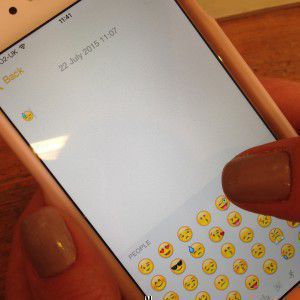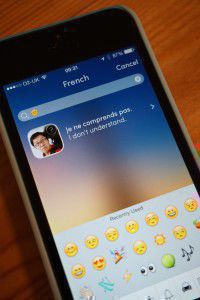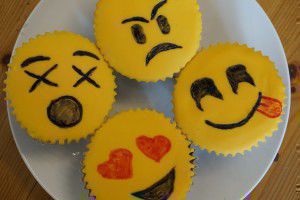Emoji: The New Universal Language?
👋👇👌 – Hi, are you okay?
👍☺️ – I’m good thanks!
👏 – yay!
Or something like that.
Welcome to the wonderful language that is emojis 😁
And before you express concern that we are confused about what is a language and what is not, hey. Your entire screen staring back up at you currently is composed of a series of ones and zeros, manipulated into the glorious thing you see before you and that, the ones and zeros, is a language all in itself. Binary code. If you’re interested.
Emojis are much, much prettier to look at than a bunch of ones and zeros though, aren’t they?
😖?
Yes, we know. Emojis can be confounding to us too. But a language is a language, and language learning is good for our cognitive reasoning 😇
So let us give you a little introduction into the wonderful world of emojis, see if we can entice you in or relieve you of your confusion. Here are some reasons why we vote emojis as our new favourite international language.
✒️📚🕐 study time!
- So firstly, you may have heard of emoticons. Emoticons are not emojis, repeat, they are not emojis ‼️ Emoticons are ‘pictures’ composed of the keyboard symbols we already have, such as :), :(, and :D. Even our mothers know how to use them.
- Emojis originate from Japan and are, like Japanese characters themselves, pictographs. The word itself means ‘picture’ – e and ‘character’ – moji. Another argument in favour of emojis being a language, don’t you think?
- Emojis actually have specific, individual meanings but in the way that colloquial language changes and adapts, they can mean different things to different people. For example, 😋 ’officially’ means face savouring delicious food, but whenever we use this in our Whatsapp messages, it generally means we are being exceptionally cheeky. Tongue sort-of in cheek, see?
- Emojis are a beautiful, universal thing, allowing people to communicate when normal language barriers would apply. And there’s no grammar! Truly, this is a joyous thing.
- Emojis are also doing their bit for diversity. The latest versions of iOS offer emoji with different skin tones:
- and the generic ‘one size fits all’ ones…
- …and those for people of the LBGT community, 👭👬🌈❤️. But none for redheads apparently. There’s a campaign on Change for that at the moment.
- Emojis are multi-platform. You can use them, in various versions on all devices, and everyone is in on the act. Even National Rail Enquiries, who, on World Emoji Day last Friday, invited Twitter followers to guess station names using a series of emojis.
It’s #WorldEmojiDay ! (Yes, it exists…) See if you can solve our quiz For help: http://t.co/wkstHtiOKE pic.twitter.com/gQGnKy4X5C
— National Rail (@nationalrailenq) July 17, 2015
- Emojis can shorten your messages and bring a smile to a recipient’s face: even if it’s just because they’re trying to understand what you mean:
🎄👜🙏?
Please come Christmas shopping with me?
✈️🎫😘
Enjoy your holiday in Cyprus!
😈🍹💻🕔?
Join me for a cheeky drink after work?
- Some businesses will even let you order dinner via Twitter: 🍕
We could go on. But we’d probably get silly.
So the next time someone shows disdain for your messages full of emojis, you are well within your rights to reply with a 😝 that says hey, I’m learning a new language here!
Are you for or against emoji? Tell us what you think!
Kelly
Language of the Week: Emoji
You may have seen on the uTalk app that you can now search for words in any of our languages by using emoji. With emoji becoming the fastest growing language in Britain, we have decided to make it our language of the week!
 If you’re anything like me, the most frequent way you choose to stay in touch with friends and family is by text messaging. If I think about it, I don’t even know what my ringtone sounds like, and I only answer my phone if I’m expecting an important call, otherwise, everyone that knows me just sends a text.
If you’re anything like me, the most frequent way you choose to stay in touch with friends and family is by text messaging. If I think about it, I don’t even know what my ringtone sounds like, and I only answer my phone if I’m expecting an important call, otherwise, everyone that knows me just sends a text.
Furthermore, I overheard this conversation the other day:
‘So he called me in the middle of the day and I thought, omg, what a freak, why can’t he just text me?‘
Okay, I was part of the conversation, but anyway you get the idea.
Nevertheless, sometimes it can be quite challenging to express your exact feelings or tone in a text, and so you risk being misunderstood by the recipient or worse – come off as too serious when you’re actually joking. So at some point in the past, the techies have come up with this brilliant way to make our text conversations more fun and emotive: emojis!
Now, some of you may not know what they are and that’s okay – my boss didn’t know either, until a couple of days ago when our app was updated with this brilliant way of searching for words by using emoji. I admit – I love emoji! They’re cute and funny and a great way to interact with your friends without using actual words.
Did you know?
- The word emoji comes from Japan, with the ‘e’ meaning picture and ‘moji’ meaning character or letter.
- There are more than 6 billion emoji sent worldwide everyday, with more than half of these being smiley faces.
- Some emoji are confusing…
- Herman Melville’s 1851 novel Moby Dick has been translated into emoji; the book was released with the title Emoji Dick.
- Many celebrities love emoji, with Roger Federer recently tweeting his whole day in emoji during Wimbledon. And in April, Andy Murray tweeted his wedding day in emoji:
🌞☔😂👔💅💇😂👰😂🚗💒💃👫🙏💍💏👏📝🎹📷🎥🚗🍷🍴🎂🎊🎉👯🎶🎤🍹🍻🍷🍺🍩🍦🍷🍹🍸🍺🌙❤💕😘💤💤💤💤💤💤💤
— Andy Murray (@andy_murray) April 11, 2015
- Even Australia’s Foreign Affairs minster, Julie Bishop gave the first ever political emoji interview on Buzzfeed.
So go ahead and see which ones have been matched with which uTalk words by our brilliant developers! Which is your favourite emoji? We love to hear from you, so please do join in the conversation here on the blog, or on Facebook or Twitter.
Ioana and Alex



